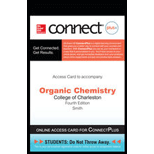
Concept explainers
Cyclohex-

cyclohex-
Want to see the full answer?
Check out a sample textbook solution
Chapter 14 Solutions
Organic Chemistry - Access (Custom)
Additional Science Textbook Solutions
Organic Chemistry - Standalone book
Chemistry & Chemical Reactivity
Chemistry: Matter and Change
Organic Chemistry (9th Edition)
Chemistry In Context
Chemistry: The Central Science (14th Edition)
- 6- Below are the figures of two infrared spectra (IR). One corresponds to the spectrum of the cyclohexane compound and the other corresponds to the cyclohexene. Identify each IV with its respective compound and indicate the frequencies and modes of vibration.arrow_forwardPredict the number of peaks and their multiplicity in the off-resonance decoupled CMR spectra of the following compounds : (a) p-Dichlorobenzene (c) 1,4-Dioxane (b) p-Xylene (d) Methyl cyclopropanearrow_forwardAn infrared spectrum of a mixture of methyl amine, CH3−NH2, and methylene imine, CH2=NH2, displayed absorptions at 1050 and 1640 cm−1cm−1, among others. Which of these two absorptions would you expect belongs to the C−N and which to the C=N stretch?arrow_forward
- What is the difference between absorption frequencies (infrared spectroscopy) for 2,3-dimethylbut-1-ene and 2,3-dimethylbut-2-ene? Why is it that the first structure has moderate intensity for the C=C bond while the second structure has weak/non-existent intensity for the "same" C=C bond?arrow_forwardLong-range coupling between protons more than two carbon atoms apart is sometimes observed when bonds intervene. An example is found in 1-methoxy-l-buten-3-yne. Not only does the acetylenic proton, Ηa, couple with the vinylic proton Hb, it also couples with the vinylic proton Hc, four carbon atoms away. The data are: Construct tree diagrams that account for the observed splitting patterns of Ηa, Hb, and Hc.arrow_forward1. An aliphatic ketone absorbs at 1,715 cm-1. What is the frequency of this vibration in hertz, which is cycles per second or just per second, reciprocal seconds? 2. What is the energy equivalent of this stretching vibration in kcal/mole? 3. Why does 3,4-diethyl-3-hexene not have a carbon to carbon double bond stretching absorption band? 4. Why does a carbon to oxygen double bond absorption band have a greater intensity than a carbon to carbon double bond absorption band? 5. Using only IR, explain in detail how one could most easily differentiate between oct-1-ene and oct-1-yne if all carbon to carbon bonds are ignored. 6. Using only IR, explain in detail how one could most easily differentiate between butan-1-ol and butanoic acid.arrow_forward
- 1-(4-methoxyphenyl)-methyl propan-1-ol. Draw a Newman projection along C(1)-C(2), with the HO group attached to C(1). Are the two methyl groups equivalent? What evidence do you find from the NMR spectrum to support your conclusion?arrow_forwardWhen 2-bromo-3,3-dimethylbutane is treated with K+ -OC(CH3)3, a single product T having molecular formula C6H12 is formed. When 3,3-dimethylbutan-2-ol is treated with H2SO4, the major product U has the same molecular formula. Given the following 1H NMR data, what are the structures of T and U? Explain in detail the splitting patterns observed for the three split signals in T.1H NMR of T: 1.01 (singlet, 9 H), 4.82 (doublet of doublets, 1 H, J = 10, 1.7 Hz), 4.93 (doublet of doublets, 1 H, J = 18, 1.7 Hz),and 5.83 (doublet of doublets, 1 H, J = 18, 10 Hz) ppm1H NMR of U: 1.60 (singlet) ppmarrow_forwardWhen the 1î-NMR spectrum of acetone, CH3COCH3, is recorded on an instrument operating at 200 MHz, a single sharp resonance at 2.1î is seen. (a) How many hertz downfield from TMS does the acetone resonance correspond to? (b) If the 1î-NMR spectrum of acetone were recorded at 500 MHz, what would the position of the absorption be in î units? (c) How many hertz downfield from TMS does this 500 MHz resonance correspond to?arrow_forward

 Organic Chemistry: A Guided InquiryChemistryISBN:9780618974122Author:Andrei StraumanisPublisher:Cengage Learning
Organic Chemistry: A Guided InquiryChemistryISBN:9780618974122Author:Andrei StraumanisPublisher:Cengage Learning Principles of Instrumental AnalysisChemistryISBN:9781305577213Author:Douglas A. Skoog, F. James Holler, Stanley R. CrouchPublisher:Cengage Learning
Principles of Instrumental AnalysisChemistryISBN:9781305577213Author:Douglas A. Skoog, F. James Holler, Stanley R. CrouchPublisher:Cengage Learning Macroscale and Microscale Organic ExperimentsChemistryISBN:9781305577190Author:Kenneth L. Williamson, Katherine M. MastersPublisher:Brooks Cole
Macroscale and Microscale Organic ExperimentsChemistryISBN:9781305577190Author:Kenneth L. Williamson, Katherine M. MastersPublisher:Brooks Cole



